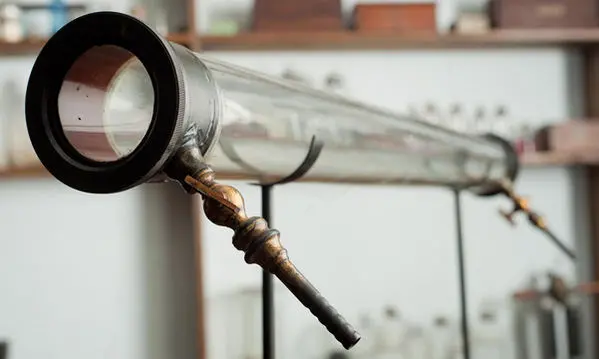Date: 1869
Place made: The Royal Institution of Great Britain, Basement Laboratory
Materials: Copper alloy, iron, glass, wax
Measurements: H: 495mm, W: 888mm, D:109mm

Description
John Tyndall was a keen mountaineer and spent quite a lot of time in the Alps, both climbing and investigating phenomena such as glaciers. This interest in nature can also be seen in many of his other diverse discoveries, including his discovery in the 1860s of why the sky is blue in the day but red at sunset.
Tyndall began to experiment with light, shining beams through various gases and liquids and recording the results. He used this simple glass tube to simulate the sky, with a white light at one end to represent the sun. He discovered that when he gradually filled the tube with smoke the beam of light appeared to be blue from the side but red from the far end.
Tyndall realised that the colour of the sky is a result of light from the sun scattering around particles in the upper atmosphere, in what is now known as the ‘Tyndall effect’. He thought that the light scattered off particles of dust or water vapour in the atmosphere, like the smoke particles in the tube, but it’s now known that the light scatters off the molecules of the air itself.
Tyndall knew that white light was made up of a whole rainbow of coloured light and thought that the blue light appeared because it was more likely to scatter off the particles. We now know that this is because it has a much shorter wavelength than red light and is much more easily scattered, so to our eyes the sky looks blue.
This experiment also explains why the sky often appears to be red in colour as the sun sets. As the sun gets lower in the sky the angle means that the light we see passes through more atmosphere. By the time it reaches us the blue light has already scattered off, leaving the longer wavelength red light to be seen.
Tyndall’s blue sky tube is a very simple but effective way of demonstrating this scattering effect. You can easily create your own version using a glass beaker of water: shine white light through the water and slowly stir in a few drops of milk at a time and see what happens.
Where can I view this?
This object is currently on display on the lower ground floor of the Faraday Museum.


